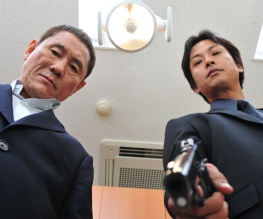Outrage

Think of mafia films, and what comes to mind? The Godfather? The Departed? Well whatever you have in your head, it won’t be anything like Outrage. The Black Movie Festival programme describes Outrage as a “violent farce”; the farce succeeds by working the audience up into such a state that its reaction is to laugh rather than be repulsed. There’s a lot of finger chopping (a traditional act of penance within the yakuza), acrobatics with a carving knife, and one scene in which a dentist’s drill is used in ways they don’t teach you in dentistry school.
The yakuza operate under a strict hierarchy, with so many levels of power it’s hard to keep up. The Chairman sits at the top of the tree and oversees all the different yakuza families; he is a man with even more power than Don Corleone (although with fewer cotton balls in his mouth), who seems to have been taking fashion tips from Kim Jong Il. Organised crime has never been so organised, until it all starts to break down of course.
The director himself takes the role of Otomo, a middle aged man who is still towards the bottom of the pile. He might have several men working for him, but he is still a pawn in the greater game. A feud begins between two of the families, and Otomo finds himself caught up in a mess of attacks and retaliation as everything begins to spiral out of control. Throughout it all Otomo’s leathery face remains expressionless, a look of resignation on his face whenever he is being reprimanded by his superiors – except, of course, when he’s dishing out the violence himself.

As a director, Kitano finds ever more creative ways of causing pain. In this world, someone only has to look at you the wrong way and they could be lucky to escape with their life. One poor African diplomat is forced to turn his embassy into a casino and work the floor; each time he tries to wriggle out of the deal, he finds himself getting pulled deeper into the machinations of the yakuza.
Amid all the chaos, Kitano’s camera finds some beautiful shots. In the opening shot we see a row of black cars, each accompanied by a bored looking chauffeur. As they all drive off in a line, two guards at the gates bow to the departing cars, framing the cars’ departure on either side of the frame. Despite this polite façade, however, this is Japan’s seedy underbelly; on the surface it might exude an old-world charm, but in reality it is not a place you’d want to visit.
The schemes, manipulations, attacks and recriminations (hey, that rhymes), all become so intertwined that after a while one struggles to keep up. It’s easier just to sit back and anticipate the next move in this highly complicated game. While most of the film weaves back and forth between the many characters, the ending is beautifully simple, but just as funny as everything that has gone before. If this is one of Kitano’s more mainstream films, we’d love to find out what he considers unconventional.
Reviewed as part of the Geneva Black Movie Festival



Recent Comments